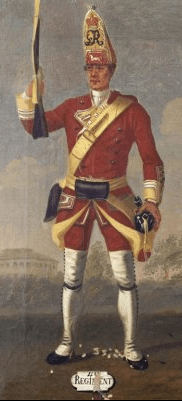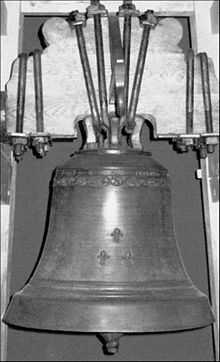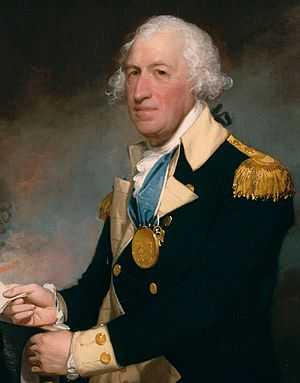Battle at Chignecto
| Battle at Chignecto | |||||||
|---|---|---|---|---|---|---|---|
| Part of Father Le Loutre’s War | |||||||
 Charles Lawrence | |||||||
| |||||||
| Belligerents | |||||||
|
Mi'kmaq militia Acadian militia |
| ||||||
| Commanders and leaders | |||||||
|
Jean-Louis Le Loutre Louis de La Corne Joseph Broussard (Beausoliel) Chief Étienne Bâtard |
Charles Lawrence John Gorham Captain John Rous Horatio Gates Captain William Clapham John Salusbury John Brewse (wounded) [1] Francis Bartelo † | ||||||
| Strength | |||||||
| 300 Mi'kmaq and Acadian militia | 700 British regulars and New England Rangers | ||||||
| Casualties and losses | |||||||
| unknown | 20 killed | ||||||
The Battle at Chignecto happened during Father Le Loutre’s War and was fought by 700 troops made up of British regulars led by Charles Lawrence, Horatio Gates, Rangers led by John Gorham and Captain John Rous led the navy.[2] This battle was the first attempt by the New Englanders to occupy the head of the Bay of Fundy since the disastrous Battle of Grand Pré three years earlier. They fought against a militia made up of Mi’kmaq and Acadians led by Jean-Louis Le Loutre and Joseph Broussard (Beausoliel). The battle happened at Isthmus of Chignecto, Nova Scotia on 3 September 1750.
Historical context

| ||||||
Despite the British Conquest of Acadia in 1710, Nova Scotia remained primarily occupied by Catholic Acadians and Mi'kmaq. By the time Cornwallis had arrived in Halifax, there was a long history of the Wabanaki Confederacy (which included the Mi'kmaq) protecting their land by killing British civilians along the New England/ Acadia border in Maine (See the Northeast Coast Campaigns 1688, 1703, 1723, 1724, 1745, 1746, 1747).[3]
To prevent the establishment of Protestant settlements in the region, Mi'kmaq raided the early British settlements of present-day Shelburne (1715) and Canso (1720). A generation later, Father Le Loutre's War began when Edward Cornwallis arrived to establish Halifax with 13 transports on June 21, 1749.[4] By unilaterally establishing Halifax the British were violating earlier treaties with the Mi'kmaq (1726), which were signed after Father Rale's War.[5]
Within 18 months of establishing Halifax, the British also took firm control of peninsula Nova Scotia by building fortifications in all the major Acadian communities: present-day Windsor (Fort Edward); Grand Pre (Fort Vieux Logis) and Chignecto (Fort Lawrence). (A British fort already existed at the other major Acadian centre of Annapolis Royal, Nova Scotia. Cobequid remained without a fort.)
After the raid in Dartmouth in 1749, on October 2, 1749, Cornwallis offered a bounty on the head of every Mi'kmaq. He set the amount at the same rate that the Mi'kmaq received from the French for British scalps. As well, to carry out this task, two companies of rangers were raised, one led by Captain Francis Bartelo and the other by Captain William Clapham. These two companies served alongside that of John Gorham's company. The three companies scoured the land around looking for Mi'kmaq.[6] After the destruction of Mirligueche (later known as Lunenburg, Nova Scotia), the Siege of Grand Pre was the first recorded conflict after Cornwallis’ bounty proclamation.
The Battle

In May 1750, Lawrence was unsuccessful in getting a base at Chignecto because Le Loutre burned the village of Beaubassin, preventing Lawrence from using its supplies to establish a fort. (According to the historian Frank Patterson, the Acadians at Cobequid also burned their homes as they retreated from the British to Tatamagouche, Nova Scotia in 1754.[7]) Lawrence retreated, but he returned in September 1750.
On September 3, 1750 Captain John Rous, Lawrence and Gorham led over 700 men (Including the 40th and 45th Regiment of Foot) to Chignecto, where Mi’kmaq and Acadians opposed their landing.[8] They had thrown up a breastwork from behind which they opposed the landing. They killed twenty British, who in turn killed several Mi’kmaq. The Mi'kmaq and Acadians killed Captain Francis Bartelo in the Battle at Chignecto.[9][10] Le Loutre's militia eventually withdrew to Beausejour, burning the rest of the Acadians' crops and houses as they went.[11]
Aftermath
On 15 October (N.S.) a group of Micmacs disguised as French officers called a member of the Nova Scotia Council Edward How to a conference. This trap, organized by Étienne Bâtard, gave him the opportunity to wound How seriously, and How died five or six days later, according to Captain La Vallière (probably Louis Leneuf de La Vallière), the only eye-witness.[12] After the battle, the British built Fort Lawrence at Chignecto and the Mi'kmaq people and Acadians continued with numerous raids on Dartmouth and Halifax.
Gallery
-

Monument to a village that was burned during the Battle at Chignecto
-

Louis de la Corne, Chevalier de la Corne, Commander at Beausejour
-

Horatio Gates fought in battle
-

45th Regiment of Foot By David Morier, 1751
References
Endnotes
- ↑ John Brewse - Canadian Biography
- ↑ Salsbury's journal re: Gates
- ↑ John Reid.“Amerindian Power in the Early Modern Northeast: A Reappraisal.” in Essays on Northeastern North America: Seventeenth and Eighteenth Centuries (Toronto: University of Toronto Press, 2008) ; Grenier, John. The Far Reaches of Empire. War in Nova Scotia, 1710-1760. University of Oklahoma Press, Norman, 2008.
- ↑ Grenier, John. The Far Reaches of Empire. War in Nova Scotia, 1710-1760. Norman: U of Oklahoma P, 2008; Thomas Beamish Akins. History of Halifax, Brookhouse Press. 1895. (2002 edition). p 7
- ↑ Wicken, p. 181; Griffith, p. 390; Also see http://www.northeastarch.com/vieux_logis.html
- ↑ Thomas Beamish Akins. History of Halifax, Brookhouse Press. 1895. (2002 edition). p 19.
- ↑ Frank Harris Patterson. History of Tatamagouche, Halifax: Royal Print & Litho., 1917 (also Mika, Belleville: 1973), p. 19
- ↑ London Magazine, 1750, p. 291
- ↑ Thomas Beamish Akins. History of Halifax, Brookhouse Press. 1895. (2002 edition). p 19; Griffith, p. 391
- ↑ p. 160
- ↑ Grenier, p. 159
- ↑ http://www.biographi.ca/009004-119.01-e.php?&id_nbr=1232
Primary Sources
- London Magazine, 1750, p. 291
- London Magazine. Vol. 19. 1750. p. 521
- The London magazine, or, Gentleman's monthly intelligencer ... v.21 1752, p. 359
Literature cited
- Faragher, John. Great and Noble Scheme. New York: Norton, 2005.
- Grenier, John. The Far Reaches of Empire. War in Nova Scotia, 1710-1760. Norman: U of Oklahoma P, 2008. pp. 154–155.
- Griffiths, Naomi Elizabeth Saundaus. From Migrant to Acadian: A North American border people, 1604-1755. Montreal, Kingston: McGill-Queen's UP, 2005.
- Landry, Peter. The Lion & The Lily. Vol. 1. Victoria: Trafford, 2007.
- Murdoch, Beamish. A History of Nova Scotia, Or Acadia. Vol 2. LaVergne: BiblioBazaar, 2009. pp. 166–167.
- Rompkey, Ronald, ed. Expeditions of Honour: The Journal of John Salusbury in Halifax, Nova Scotia, 1749-53. Newark: U of Delaware P, Newark, 1982.